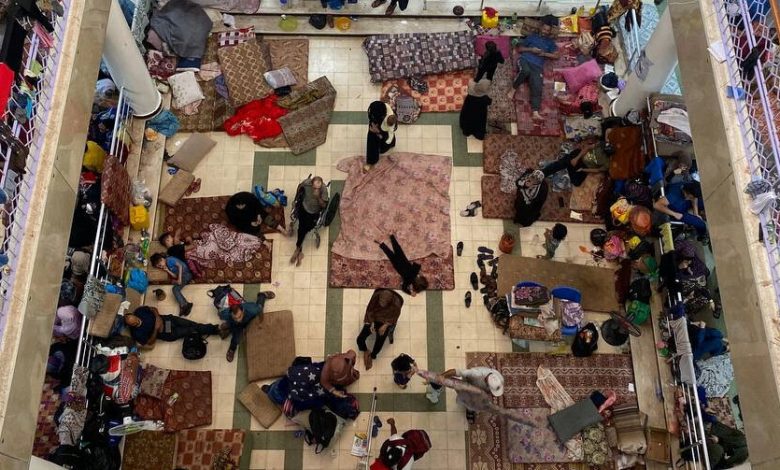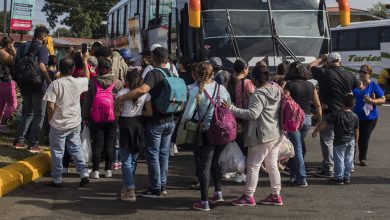Inside the Desperate Effort to Evacuate Young Cancer Patients From Gaza

They are some of the most vulnerable in Gaza.
The youngest is not even a year old; the oldest is 14. All are battling lymphoma, leukemia and tumors that doctors said could kill them if left untreated.
Over the past 10 days, 21 children with cancer have been evacuated from Gaza to hospitals in Egypt and Jordan, according to doctors involved in the effort. But at least 30 other young cancer patients have not made it out, and aid workers said that in the chaos of war, they can no longer reach some of the families.
“This is catastrophic,” said Dr. Bakr Gaoud, the head of Al-Rantisi Specialized Hospital for Children, which was the only medical center with a pediatric cancer ward in Gaza until it was forced to shut down on Friday during heavy fighting. Even before the hospital closed, critically ill patients were being sent home through violent streets or transferred to Al-Shifa, a nearby hospital that is under siege by Israeli forces.
Hospitals have become a particular flashpoint in the war as Israel has accused Hamas of turning medical facilities, including Al-Rantisi and Al-Shifa, into safe houses and command centers. Hamas and hospital officials have denied the allegations.
The effort to evacuate children with cancer began in mid-October and required negotiations among the White House, Egypt, Israel and Palestinian health officials in Gaza, which is controlled by Hamas.
But those involved in the evacuation said it has proceeded fitfully.
Aid workers and doctors, who spoke on condition of anonymity because of the sensitivity of the efforts, described frantic families who lost their cell service and missed the specific days when their children had been given permission to cross into Egypt. Some waited for hours for ambulances that never made it to a meeting point.
One family arrived at the border only to discover that their child had been approved to cross, but the parent’s name had been inexplicably left off the list.
The children’s plight is a microcosm of the suffering in Gaza since the war began just over a month ago, after Hamas launched a surprise assault that Israeli authorities say killed 1,200 people. Israel’s retaliation has killed more than 11,000 people, including more than 4,500 children, according to health officials in Gaza.
Most of the children with cancer were being treated at Al-Rantisi, which had 35 inpatient pediatric cancer patients as of two weeks ago, Dr. Gaoud said. But as shells hit the hospital’s water tanks and power system over the past week, it began to empty out.
On Friday, Dr. Gaoud said, Al-Rantisi was forced to shut down entirely, with staff members dragging some patients outside in their beds to wait for ambulances. Israeli soldiers provided a map of what they said was a safe route through the fighting.
The children were given one last dose of chemotherapy before they left. Without further care, Dr. Gaoud said, “their cases will deteriorate.”
The emergency effort to evacuate the patients was organized by the World Health Organization and St. Jude Children’s Research Hospital, which had been involved in building up services at Al-Rantisi.
The organizations created a registry of children to be moved, with phone numbers for their relatives. St. Jude’s also promised to organize their transport into Egypt and ensure their medical care.
But the names of the children had to be added to a daily list of those approved to pass through the Rafah border crossing into Egypt, which was no simple task. More than two weeks passed with no evacuations.
St. Jude’s appealed to the White House, which had partnered with the organization on a similar evacuation of pediatric cancer patients in Ukraine. Desperate messages from hospitals were already fueling the Biden administration’s push for humanitarian pauses in the conflict, according to a senior administration official, who spoke on the condition of anonymity to discuss internal White House communications.
The official was shown text messages from medical workers in Gaza. One that reached the White House came from an Al-Rantisi nurse.
“Never in my life did I think we as a cancer hospital will be under siege with missiles, and phosphorus bombs are everywhere,” the nurse wrote. “I swear I said we need to get our message and voice out. Speak to the White House, to anyone.”
“This is enough, stop, this is enough. We are a hospital for kids,” the message said. “Many are taking shelter, and none of them have any weapons or anything. They lift their hands and ask for help. These are sick cancer kids. This is a catastrophe.”
U.S. officials have managed to secure passage of some 400 Americans through the Rafah crossing into Egypt since the war began, and they used those same channels to help get the pediatric cancer patients on the list for safe passage, according to a senior administration official.
The list of people allowed through the crossing is compiled daily and is coordinated by Egypt, which has taken in the bulk of the evacuees. Israel, which vets the list to ensure that it does not include Hamas fighters, raised no objection to the Americans’ request to make the patients a priority, a senior administration official said.
Curtis Ried, the chief of staff for the National Security Council, said President Biden “directed us to do whatever we could to help these kids get out.”
“So we’re still hopeful and we’re still pushing every day to see if we can help get these other children out,” Mr. Ried said.
On Monday, as Gaza’s health system collapsed by the hour, Mr. Biden said his “hope and expectation is that there will be less intrusive action relative to hospitals” and that the United States had continued to be in contact with Israel on the issue.
“So I remain somewhat hopeful, but hospitals must be protected,” he added.
The first patient crossed on Nov. 4, followed by eight more two days later, then several more groups for a total of 21 as of Tuesday. The remaining children, whose ages ranged from a few months to 14, have been approved to leave, but it is unclear when or whether they will be able to given the violence in the streets.
Most of the children who have not made it out yet are trapped in northern Gaza, where the fighting is raging, a doctor involved in the evacuation said. An aid worker said one family walked 11 hours to make it to the Rafah crossing.
A 7-year-old girl was among the most dire cases. When the war started, she had just been diagnosed with leukemia, or blood cancer, according to doctors involved in the evacuation effort. She had been scheduled to be taken outside Gaza for care. But she could not be moved because of the violence, and her white blood cell count rose dangerously high.
As the fighting intensified, her family fled with her to southern Gaza, looking for safety and shelter. When the girl was approved for evacuation, aid workers were unable to reach her parent for two days because of problems with telephone service.
When they finally got in contact, an ambulance was hastily organized to get the girl to the border. But that day, for some reason, no one was allowed to cross. Only in the past few days did the girl make it to Egypt.
Dr. Rik Peeperkorn, the W.H.O.’s representative for Gaza and the West Bank, said the evacuation of the children so far is “a small glimmer of hope” in an overwhelming humanitarian crisis. But, he added, “Many more children and adults urgently need medical evacuation outside Gaza. Time is running out for them.”
He also said that the breakdown in medical care will mean some children with cancer will not even be diagnosed.
At Al-Rantisi, the families of the pediatric cancer patients were a close-knit group, doctors and aid workers say. Some had known one another since their babies were born, and they had comforted one another through diagnoses and treatments. In recent weeks, they took refuge together in their children’s hospital rooms to stay safe from bombardments. They even managed to be happy for their friends who had been called from the evacuation list, even as they agonized over whether their own children ever would be.
But now, many are feared “scattered into the streets,” said Steve Sosebee, the founder and president of the Palestine Children’s Relief Fund, which opened the oncology ward at Al-Rantisi in 2019, building up a supply of cancer drugs and a training staff.
When the bombardments began, many families decided that they would go the rest of their cancer journey alone. “Some families took it upon themselves to leave, even though they had no place to go and their child had no alternative medical care available to them outside of the department,” Mr. Sosebee said.
Al-Rantisi’s young cancer patients had endured conflicts before that had disrupted their treatment. But never such a confluence of risks — including bombings, dehydration and malnutrition, said Dr. Zeena Salman, a pediatric oncologist based in the United States who has worked with patients in Gaza for eight years.
“In this case, the stakes are much, much higher for these children,” Dr. Salman said. “The ones who are spared deaths from bombs, certainly these delays in their treatment, put them at higher risk. So, there’s kind of a risk of acute death, or if they survive, the risk of not being able to be cured of their cancer.”
Abu Bakr Bashir contributed reporting from London.




